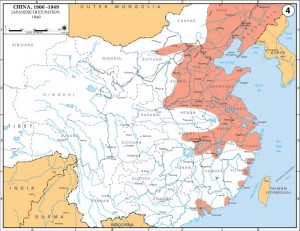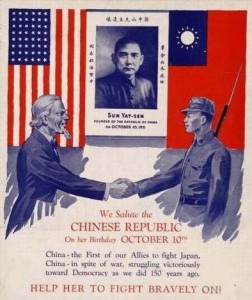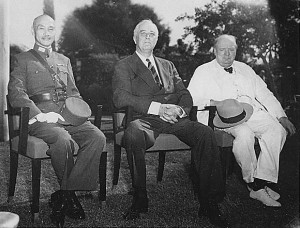 The Second Sino-Japanese War began on July 7, 1937 and ended on September 9, 1945 after Japan surrendered to China and the Allied forces. This war ignited from a conflict between Chinese and Japanese troops for control of Chinese mainland. The Second Sino-Japanese War was the biggest Asian war in the twentieth century and contributed to more than 50 percent of casualties in the Pacific War. This war merged into World War II, after Japan attacked Pearl Harbor in 1941. In addition to that, the war played a big role in the ultimate Communist defeat of the Nationalist troops in 1949.
The Second Sino-Japanese War began on July 7, 1937 and ended on September 9, 1945 after Japan surrendered to China and the Allied forces. This war ignited from a conflict between Chinese and Japanese troops for control of Chinese mainland. The Second Sino-Japanese War was the biggest Asian war in the twentieth century and contributed to more than 50 percent of casualties in the Pacific War. This war merged into World War II, after Japan attacked Pearl Harbor in 1941. In addition to that, the war played a big role in the ultimate Communist defeat of the Nationalist troops in 1949.
Origin
The origin of the Second Sino-Japanese War can be traced back to the First Sino-Japanese War that lasted from 1894 to 1895. After the end of First Sino-Japanese War which made Korea a part of Japan, Japan took her troops along a railroad from Manchuria to Korean ports-of-trade. This railroad was used to transport raw materials and other finished goods to Korean docks to be shipped to Japan. Japanese troops controlled this railway and wanted more free resources from Manchuria. Therefore, the Japanese started to attack Chinese troops and succeeded in gaining control of Manchuria. Although Chinese had insufficient resources, they managed to fight back especially after receiving economic help from the Soviet Union and the U.S.
Outbreak
The leader of Nationalist government’s forces, Chiang Kai-Shek, was kidnapped in 1936 by Chang Hsueh-liang, commander of the Communist forces. Chiang was forced to agree to have a common anti-Japanese front as a condition for his release. With the two sides united, they were able to defend themselves against the Japanese in Manchuria and North China. This resulted in the commencement of the Second Sino-Japanese War.
Japan’s Strategy
 Japan aimed at taking all roads, railroads, and cities, in order to gain total control. Despite the fact that Japanese forces were controlling the eastern coastal region, guerrilla fighting continued in the conquered areas. The Chinese Nationalist government had been forced to retreat to a transitory capital at Chongqing. However, Japanese did not have the capability or intention of directly controlling all of China. So, they set up friendly “puppet” governments which would favor their interests. These governments were not very popular especially after Japan refused to negotiate with China’s Communist Party.
Japan aimed at taking all roads, railroads, and cities, in order to gain total control. Despite the fact that Japanese forces were controlling the eastern coastal region, guerrilla fighting continued in the conquered areas. The Chinese Nationalist government had been forced to retreat to a transitory capital at Chongqing. However, Japanese did not have the capability or intention of directly controlling all of China. So, they set up friendly “puppet” governments which would favor their interests. These governments were not very popular especially after Japan refused to negotiate with China’s Communist Party.
China’s Strategy
China, on the other hand, was not ready for war. Moreover, she had few mechanized divisions, lacked significant military industrial strength, and had no armor support. China largely depended on the League-of-Nations to come to her aid and offer countermeasures to Japan’s assault. Furthermore, the Kuomintang, or the Chinese Nationalist Party, was caught up in an internal fight against the Communists. Due to all these disadvantages, the Chinese were forced to come up with a strategy which aimed at preserving their army strength. In addition to that, occupied areas would continue to exert pockets of resistance in order to disturb Japanese forces and make their control of China as difficult as possible.
Foreign Aid for China
 After the Japanese left the League of Nations in 1933, they practiced an aggressive foreign policy whose aim was to create the Greater East Asia Co-prosperity Sphere. This offered a serious threat to the economic influences and interests of European powers and the U.S. in Asia. When the Second Sino-Japanese War broke out, the United State’s government imposed economic sanctions on the Japanese. Japan turned to the Axis Powers and signed the Tripartite Pact with Italy and Germany in 1940. Japan managed to occupy French Indochina in mid 1941, but the U.S. continued to avoid any direct confrontation. However, Japan’s imperial goals in the Pacific led to an untimely collision with U.S.A. The United States responded by imposing an oil ban which would suffocate Japan’s economy. For this reason, Japan strategized on how to remove the U.S. from the Pacific region so as to control the whole of Southeast Asia.
After the Japanese left the League of Nations in 1933, they practiced an aggressive foreign policy whose aim was to create the Greater East Asia Co-prosperity Sphere. This offered a serious threat to the economic influences and interests of European powers and the U.S. in Asia. When the Second Sino-Japanese War broke out, the United State’s government imposed economic sanctions on the Japanese. Japan turned to the Axis Powers and signed the Tripartite Pact with Italy and Germany in 1940. Japan managed to occupy French Indochina in mid 1941, but the U.S. continued to avoid any direct confrontation. However, Japan’s imperial goals in the Pacific led to an untimely collision with U.S.A. The United States responded by imposing an oil ban which would suffocate Japan’s economy. For this reason, Japan strategized on how to remove the U.S. from the Pacific region so as to control the whole of Southeast Asia.
When Japanese bombed the Pearl Harbor, the United states and China declared war against Japan. This merged the second Sino-Japanese War into World War II. China also declared war on Italy and Germany. Eight hours after the bombing, Japan attacked Hong Kong and destroyed the Allied forces’ aircrafts. Britain and the U.S. offered financial support to China as well as setting up military air bases on the mainland. This support from Britain and the U.S. relieved China, and forced Japan to divert troops elsewhere. Nonetheless, China’s military strength continued to worsen until April, 1945. The Japanese seemed unstoppable, especially after sinking Britain’s two biggest warships in Singapore during an air attack on December 10, 1941.
Japan’s Surrender
With help from the western allies, China managed to launch a successful offensive on August 14 1945, at Zhijiang. This was a big blow to the Japanese who had been winning consistent victories. The U.S.A. dropped an atomic-bomb on Hiroshima on August 6, 1945. Three days later, the Soviet Union attacked the Japanese in Manchuria. On August 9, 1945, the U.S. dropped another atomic bomb, this time on Nagasaki. Emperor Hirohito of Japan officially surrendered to the Allies on August 15, 1945. The Soviet Union on the other hand continued to attack the Kwantung Army (the main Japanese fighting force) and destroyed them completely within two weeks. Japan’s official surrender to the Allies was signed on September 2, 1945 aboard the USS Missouri battleship.
Now that the Allied Forces had won the war, Gen. Douglas ordered all Japanese troops within China (except those in Manchuria), French Indochina and Formosa to surrender to Chiang Kai-Shek. The Japanese forces in China surrendered officially on September 9, 1945, marking the end of the 2nd Sino-Japanese War as well as World War II. In addition to that, Taiwan, the Pescadores and Manchuria were restored to China, as per the conditions of the Cairo Declaration.